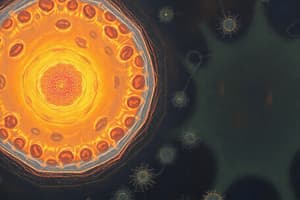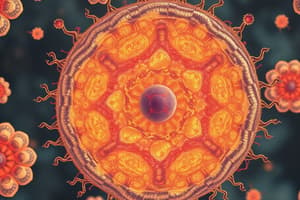Podcast
Questions and Answers
A eukaryotic flagellum's movement is driven by which structural component?
A eukaryotic flagellum's movement is driven by which structural component?
- The sliding of actin filaments powered by ATP hydrolysis associated with dynein.
- The contraction of a surrounding sheath of contractile proteins, similar to muscle cells.
- The coordinated beating of tubulin-based microtubules in a '9+2' arrangement, powered by dynein. (correct)
- The rotation of peptidoglycan chains within the cell wall.
Which characteristic fundamentally differentiates eukaryotic cell walls from bacterial cell walls?
Which characteristic fundamentally differentiates eukaryotic cell walls from bacterial cell walls?
- Eukaryotic cell walls are composed of a single layer of lipids, contrasting with the multiple layers in bacteria.
- Eukaryotic cell walls contain chitin, while bacterial cell walls contain cellulose.
- Eukaryotic cell walls lack peptidoglycan, a component universally found in bacterial cell walls. (correct)
- Eukaryotic cell walls contain teichoic acids, whereas bacterial cell walls do not.
What distinguishes cilia from flagella in eukaryotic cells?
What distinguishes cilia from flagella in eukaryotic cells?
- Cilia are composed of actin filaments, whereas flagella are composed of tubulin.
- Cilia are typically more numerous and shorter than flagella. (correct)
- Cilia propel cells through their environment, while flagella move substances across the cell surface.
- Cilia contain a '9+2' arrangement of microtubules, while flagella have a '9+0' arrangement.
Considering both structure and function, what is the primary role of the '9+0' microtubule arrangement in certain eukaryotic cilia?
Considering both structure and function, what is the primary role of the '9+0' microtubule arrangement in certain eukaryotic cilia?
How does the arrangement of microtubules within eukaryotic flagella contribute to their characteristic wave-like motion?
How does the arrangement of microtubules within eukaryotic flagella contribute to their characteristic wave-like motion?
Which characteristic is MOST likely to remain constant across multiple generations of a monomorphic bacterial species, assuming stable environmental conditions?
Which characteristic is MOST likely to remain constant across multiple generations of a monomorphic bacterial species, assuming stable environmental conditions?
A microbiologist discovers a new prokaryotic species with a highly variable morphology depending on nutrient availability. Which term BEST describes this characteristic?
A microbiologist discovers a new prokaryotic species with a highly variable morphology depending on nutrient availability. Which term BEST describes this characteristic?
In a mixed bacterial culture, what is the MOST reliable initial method for differentiating between Streptococcus (cocci) and Bacillus (bacilli) species?
In a mixed bacterial culture, what is the MOST reliable initial method for differentiating between Streptococcus (cocci) and Bacillus (bacilli) species?
A bacterial species is found to produce a thick, well-organized glycocalyx layer. How would this likely influence the bacteria's interactions within a host organism?
A bacterial species is found to produce a thick, well-organized glycocalyx layer. How would this likely influence the bacteria's interactions within a host organism?
A researcher is studying two bacterial strains: one with a capsule and one without. What is a plausible hypothesis regarding their respective abilities to cause disease?
A researcher is studying two bacterial strains: one with a capsule and one without. What is a plausible hypothesis regarding their respective abilities to cause disease?
A bacterium is isolated from a patient's bloodstream and determined to be highly virulent due to its glycocalyx. Further analysis reveals this layer is loosely attached. Which term BEST describes this type of glycocalyx?
A bacterium is isolated from a patient's bloodstream and determined to be highly virulent due to its glycocalyx. Further analysis reveals this layer is loosely attached. Which term BEST describes this type of glycocalyx?
Considering that bacterial morphology is primarily determined by hereditary factors, what cellular component is MOST directly responsible for maintaining a bacterium's characteristic shape?
Considering that bacterial morphology is primarily determined by hereditary factors, what cellular component is MOST directly responsible for maintaining a bacterium's characteristic shape?
How does the presence of a capsule contribute to the virulence of a pathogenic bacterium?
How does the presence of a capsule contribute to the virulence of a pathogenic bacterium?
What is the primary mechanism by which prokaryotic flagella facilitate bacterial motility?
What is the primary mechanism by which prokaryotic flagella facilitate bacterial motility?
A researcher is studying two strains of the same bacterial species, one encapsulated and one unencapsulated. If both strains are introduced into a host organism, what is the most likely outcome?
A researcher is studying two strains of the same bacterial species, one encapsulated and one unencapsulated. If both strains are introduced into a host organism, what is the most likely outcome?
If a bacterium loses its capsule, what is the most likely consequence?
If a bacterium loses its capsule, what is the most likely consequence?
Which of the following cellular structures is LEAST likely to be directly involved in bacterial motility?
Which of the following cellular structures is LEAST likely to be directly involved in bacterial motility?
A microbiologist is trying to identify a bacterial species based on its flagellar proteins. Which of the following statements is true about this approach?
A microbiologist is trying to identify a bacterial species based on its flagellar proteins. Which of the following statements is true about this approach?
A bacterial strain is found to be highly virulent due to its ability to evade the host's immune system. Which of the following virulence factors is MOST likely responsible for this?
A bacterial strain is found to be highly virulent due to its ability to evade the host's immune system. Which of the following virulence factors is MOST likely responsible for this?
A researcher discovers a new bacterial species that is non-motile despite possessing flagella. What is the most likely explanation for this observation?
A researcher discovers a new bacterial species that is non-motile despite possessing flagella. What is the most likely explanation for this observation?
Capsules are composed of repeating carbohydrate subunits. What is the advantage of this for the bacteria?
Capsules are composed of repeating carbohydrate subunits. What is the advantage of this for the bacteria?
How does the structure of eukaryotic flagella differ significantly from that of bacterial flagella?
How does the structure of eukaryotic flagella differ significantly from that of bacterial flagella?
Which bacterial flagellar arrangement describes flagella distributed evenly over the entire cell surface?
Which bacterial flagellar arrangement describes flagella distributed evenly over the entire cell surface?
What is the underlying mechanism that allows bacteria to exhibit chemotaxis?
What is the underlying mechanism that allows bacteria to exhibit chemotaxis?
How do axial filaments contribute to the unique motility observed in spirochetes?
How do axial filaments contribute to the unique motility observed in spirochetes?
What role do fimbriae play in the formation and maintenance of biofilms?
What role do fimbriae play in the formation and maintenance of biofilms?
What is the primary functional difference between fimbriae and pili related to bacterial adherence?
What is the primary functional difference between fimbriae and pili related to bacterial adherence?
How does the presence of a capsule enhance a bacterium's pathogenicity?
How does the presence of a capsule enhance a bacterium's pathogenicity?
What is the role of mycolic acid in the cell walls of acid-fast bacteria like Mycobacterium?
What is the role of mycolic acid in the cell walls of acid-fast bacteria like Mycobacterium?
What is the significance of lipopolysaccharide (LPS) in Gram-negative bacterial infections?
What is the significance of lipopolysaccharide (LPS) in Gram-negative bacterial infections?
How do bacterial endospores contribute to the survival and persistence of certain pathogenic species?
How do bacterial endospores contribute to the survival and persistence of certain pathogenic species?
In a scenario where a bacterial cell is in an environment with a lower concentration of nutrients than inside the cell, which transport mechanism is most likely to be employed to maintain nutrient levels, and why?
In a scenario where a bacterial cell is in an environment with a lower concentration of nutrients than inside the cell, which transport mechanism is most likely to be employed to maintain nutrient levels, and why?
If a bacterial cell is placed in a hypertonic solution, what physiological response is most likely to occur as a direct consequence of the osmotic pressure difference?
If a bacterial cell is placed in a hypertonic solution, what physiological response is most likely to occur as a direct consequence of the osmotic pressure difference?
How does the organization of genetic material within the nucleoid of a bacterial cell differ fundamentally from that in a eukaryotic cell nucleus, and what implications does this have for genetic processes?
How does the organization of genetic material within the nucleoid of a bacterial cell differ fundamentally from that in a eukaryotic cell nucleus, and what implications does this have for genetic processes?
In the context of bacterial genetics, what is the most significant evolutionary advantage conferred by plasmids, particularly under conditions of environmental stress or selective pressure?
In the context of bacterial genetics, what is the most significant evolutionary advantage conferred by plasmids, particularly under conditions of environmental stress or selective pressure?
What is the primary role of the bacterial cytoplasm's cytosol, and how does its composition contribute to essential cellular processes?
What is the primary role of the bacterial cytoplasm's cytosol, and how does its composition contribute to essential cellular processes?
A bacterial cell encounters a sudden increase in environmental osmolarity. What immediate response at the cellular level is most critical for preventing cellular damage?
A bacterial cell encounters a sudden increase in environmental osmolarity. What immediate response at the cellular level is most critical for preventing cellular damage?
How does the absence of histones in bacterial chromosomes affect DNA accessibility and gene expression compared to eukaryotic chromosomes?
How does the absence of histones in bacterial chromosomes affect DNA accessibility and gene expression compared to eukaryotic chromosomes?
A bacterium gains a plasmid carrying a gene for a novel enzyme that degrades an environmental pollutant. Under what conditions would this plasmid be most selectively advantageous?
A bacterium gains a plasmid carrying a gene for a novel enzyme that degrades an environmental pollutant. Under what conditions would this plasmid be most selectively advantageous?
How does the relatively high water content (80%) of the bacterial cytosol directly support the biochemical reactions necessary for life?
How does the relatively high water content (80%) of the bacterial cytosol directly support the biochemical reactions necessary for life?
A scientist discovers a new bacterial species with a unique plasmid that seems to enhance its virulence. Which experimental approach would be most effective in determining the specific gene on the plasmid responsible for this increased virulence?
A scientist discovers a new bacterial species with a unique plasmid that seems to enhance its virulence. Which experimental approach would be most effective in determining the specific gene on the plasmid responsible for this increased virulence?
Flashcards
Flagella
Flagella
Long, few structures for cell motility, made of tubulin.
Cilia
Cilia
Short, numerous structures that help in movement and moving substances.
9+2 arrangement
9+2 arrangement
Structure of microtubules in flagella and cilia, consisting of 9 pairs and 2 central tubules.
Eukaryotic cell wall
Eukaryotic cell wall
Signup and view all the flashcards
Microtubules
Microtubules
Signup and view all the flashcards
Prokaryotic Cell Morphology
Prokaryotic Cell Morphology
Signup and view all the flashcards
Cocci
Cocci
Signup and view all the flashcards
Bacilli
Bacilli
Signup and view all the flashcards
Spiral
Spiral
Signup and view all the flashcards
Pleomorphic
Pleomorphic
Signup and view all the flashcards
Glycocalyx
Glycocalyx
Signup and view all the flashcards
Capsule
Capsule
Signup and view all the flashcards
Pathogenic
Pathogenic
Signup and view all the flashcards
Virulence factor
Virulence factor
Signup and view all the flashcards
Capsule (bacterial)
Capsule (bacterial)
Signup and view all the flashcards
Desiccation protection
Desiccation protection
Signup and view all the flashcards
Host recognition evasion
Host recognition evasion
Signup and view all the flashcards
Unencapsulated bacteria
Unencapsulated bacteria
Signup and view all the flashcards
Prokaryotic flagella
Prokaryotic flagella
Signup and view all the flashcards
Flagellar movement
Flagellar movement
Signup and view all the flashcards
Staining for capsules
Staining for capsules
Signup and view all the flashcards
Osmosis
Osmosis
Signup and view all the flashcards
Isotonic Solution
Isotonic Solution
Signup and view all the flashcards
Hypertonic Solution
Hypertonic Solution
Signup and view all the flashcards
Hypotonic Solution
Hypotonic Solution
Signup and view all the flashcards
Active Transport
Active Transport
Signup and view all the flashcards
Cytoplasm
Cytoplasm
Signup and view all the flashcards
Nucleoid
Nucleoid
Signup and view all the flashcards
Plasmids
Plasmids
Signup and view all the flashcards
Ribosomes
Ribosomes
Signup and view all the flashcards
Inclusions
Inclusions
Signup and view all the flashcards
coli O157:H7
coli O157:H7
Signup and view all the flashcards
Flagellar Protein
Flagellar Protein
Signup and view all the flashcards
Motility
Motility
Signup and view all the flashcards
Chemotaxis
Chemotaxis
Signup and view all the flashcards
Phototaxis
Phototaxis
Signup and view all the flashcards
Axial Filaments
Axial Filaments
Signup and view all the flashcards
Spirochetes
Spirochetes
Signup and view all the flashcards
Fimbriae
Fimbriae
Signup and view all the flashcards
Taxis
Taxis
Signup and view all the flashcards
Study Notes
Cell Structure & Function
- Cells are the fundamental units of life, exhibiting characteristics of life, including growth, reproduction, responsiveness, and metabolism.
- Microbes, like bacteria, archaea, eukaryotes, and viruses, vary in their characteristics and distribution of life functions.
- Growth, reproduction, and responsiveness occur in all bacteria, archaea, and eukaryotes, but viruses lack growth and rely on host cells for reproduction. Metabolic functions are present in all. Viruses use host cell metabolism, while cellular structure is absent in viruses.
- Prokaryotic cells (bacteria and archaea) lack a nucleus and membrane-enclosed organelles.
- Eukaryotic cells (fungi, protozoa, helminths, plants, and algae) contain a nucleus and numerous membrane-bound organelles.
- Similar chemical composition, including nucleic acids (DNA and RNA) and proteins, is found in both prokaryotic and eukaryotic cells. Similar chemical processes like metabolism, protein production, and energy storage happen in both cells.
- Prokaryotes have a single circular chromosome, lack membrane-bound organelles, and have cell walls, in most cases containing peptidoglycan. Cell division is by binary fission and prokaryotic cells are less complex than eukaryotic cells
- Eukaryotes have multiple linear chromosomes, contain membrane-bound organelles, and, when present, cell walls do not contain peptidoglycan. Eukaryotic division is by mitosis.
- Bacterial species are identified by morphology (shape), chemical composition, and biochemical activities. Shape can be cocci, bacilli, spiral, or pleomorphic.
- Prokaryotic cells have a cell wall, cell membrane, cytoplasm, ribosomes, glycocalyx, flagella, fimbriae, pili, and plasmids, and sometimes inclusions and endospores
- Eukaryotic cells have a cell membrane, cytosol, ribosomes, cytoskeleton, membrane-bound organelles (like nuclei, endoplasmic reticulum, Golgi apparatus, vacuoles, lysosomes, peroxisomes, and mitochondria) and sometimes cilia and flagella
- The glycocalyx, a sugar coat, may be a capsule (firmly attached) or slime layer (loosely attached). It can protect cells from dehydration and enhance pathogenicity.
- Flagella are whip-like structures for motility, with filaments, hooks, and basal bodies. Movement occurs via hook rotation.
- Fimbriae are short, numerous, sticky, hairlike appendages aiding in attachment. Pili are longer, few, and also for adhesion, often facilitating conjugation (DNA transfer).
- Cell walls encase plasma membranes, providing shape and structural support. Peptidoglycan is a key component in bacterial cell walls.
- Gram-positive cells have thick peptidoglycan layers with teichoic and lipoteichoic acids, while gram-negative cells have thin peptidoglycan layers with an outer membrane. Mycoplasmas lack cell walls, and mycobacteria have mycolic acids in their cell walls. Archaea have pseudomurein instead of peptidoglycan.
- Plasma membranes enclose the cytoplasm and control entry of materials into and out of the cell, through mechanisms like diffusion and osmosis. Integral proteins, peripheral proteins, and glycoproteins are important membrane components.
- Cytoplasm is the liquid content of cells, containing water and various compounds including proteins, enzymes, carbohydrates, and ions.
- Nucleoid area is the location of the genetic material in prokaryotes (circular DNA) compared to eukaryotes' linear chromosomes. Plasmids are extrachromosomal genetic elements replicating independently.
- Ribosomes are protein synthesis sites, but prokaryotic ones are 70S, and eukaryotic 80S.
- Endospores are dormant, highly resistant structures produced by some bacteria to survive harsh conditions. They are located centrally, sub-terminally, or terminally in the bacterial cells.
- Eukaryotic cells have sophisticated internal structures including cilia and flagella made of microtuble arrangements, and a more complex cytoskeleton for internal support and transport than prokaryotic cells. Eukaryotic DNA is organized around histones into linear chromosomes.
- Eukaryotic cells are larger and typically possess membrane bound organelles such as the nucleus, endoplasmic reticulum, Golgi apparatus, and mitochondria
- Movement across cell membranes can involve passive processes (simple diffusion, facilitated diffusion, osmosis) or active transport. Active transport involves the use of energy to move substances against a concentration gradient.
Special Cell Structures
- Glycocalyx: A sugar coat that aids in attachment and protection.
- Flagella: Whip-like structures for movement.
- Fimbriae: Short, numerous, sticky, hairlike appendages for attachment.
- Pili: Longer, thinner structures involved in adherence and conjugation.
- Endospores: Dormant, resistant structures formed by bacteria to survive unfavorable conditions.
- Different types of specialized structures exist, especially in bacteria.
Types of Cells
- Prokaryotic cells (bacteria and archaea)
- Eukaryotic cells (fungi, protozoa, helminths, plants, algae)
Movement Across the Membrane
- Passive processes: diffusion, osmosis, and facilitated diffusion.
- Active transport: using energy to move substances against the concentration gradient.
Typical Bacterial Cell
- Cell wall (peptidoglycan)
- Cell membrane (sites of cellular respiration)
- Cytoplasm (rich in 70S ribosomes)
- Nucleoid (single circular chromosome)
- Plasmid
- Inclusions
- Flagella
- Glycocalyx
- Ribosomes
Eukaryotic Cell structures
- Plasma membrane
- Cytoplasm
- Cytoskeleton
- Ribosomes
- Nucleus
- Nucleolus
- Endoplasmic reticulum (rough and smooth)
- Golgi apparatus
- Lysosomes
- Peroxisomes
- Mitochondria
- Vacuoles
- Cilia
- Flagella
Concept Checks
- Answers to specific questions about cell structures and functions are present.
Studying That Suits You
Use AI to generate personalized quizzes and flashcards to suit your learning preferences.




